
Sir Joseph Whitworth, 1st Baronet was an English engineer, entrepreneur, inventor and philanthropist. In 1841, he devised the British Standard Whitworth system, which created an accepted standard for screw threads. Whitworth also created the Whitworth rifle, often called the "sharpshooter" because of its accuracy, which is considered one of the earliest examples of a sniper rifle, used by some Confederate forces during the American Civil war.

Darley Dale, formerly Darley, is a town and civil parish in the Derbyshire Dales district of Derbyshire, England, with a population of 5,413. It lies north of Matlock, on the River Derwent and the A6 road. The town forms part of a built-up area with both Matlock and Rowsley.
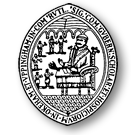
Uppingham School is a public school in Uppingham, Rutland, England, founded in 1584 by Robert Johnson, the Archdeacon of Leicester, who also established Oakham School. The headmaster, Richard Maloney, belongs to the Headmasters' and Headmistresses' Conference and the school to the Rugby Group of British independent schools. Edward Thring was the school's best-known headmaster. His curriculum changes were adopted in other English public schools. John Wolfenden, headmaster from 1934 to 1944, chaired the Wolfenden Committee, whose report recommending the decriminalisation of homosexuality appeared in 1957. Uppingham has a musical tradition based on work by Paul David and Robert Sterndale Bennett. It has the biggest playing-field area of any school in England, in three separate areas of the town: Leicester to the west, Middle to the south, and Upper to the east.

The Baronetcy of Gresley of Drakelow was created in the Baronetage of England on 29 June 1611 for George Gresley of Drakelow Hall, Derbyshire who was later High Sheriff of Derbyshire and Member of Parliament for Newcastle-under-Lyme.
The Kniveton Baronetcy, of Mercaston in the County of Derby, was a title in the Baronetage of England. It was created by King James I on 29 June 1611 for William Kniveton of Mercaston Hall, Muggington, Derbyshire. The family originated in the village of Kniveton,, from where their name derived. Branches of the family later had seats at Bradley and by virtue of the 15th century marriage of Nicholas Kniveton, at Mercaston, near Muggington, Derby

Duffield Hall is a 17th-century country house situated in the Amber Valley, Derbyshire and the former headquarters of the Derbyshire Building Society. It is a Grade II* listed building.

Butterley Hall is an 18th-century country house near Ripley, Derbyshire. It is a Grade II listed building. The site is now the headquarters of the Derbyshire Constabulary.
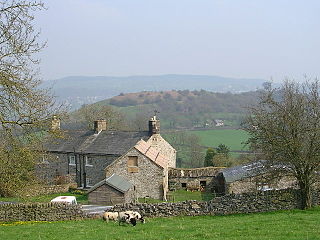
Wensley is a small village in South Darley parish in Derbyshire of limestone and gritstone properties mainly arranged along the single road which zig-zags through the village or around the square. The whole village, together with part of the adjacent Wensley Dale is a Conservation Area. Until fairly recently there was a Methodist Chapel, a village shop and two public houses, but these have all closed. The former school is now a village hall, Wensley Reading Room. Quite a few of the houses are holiday lets.

Markeaton Hall was an 18th-century country house in Markeaton, Derbyshire.
Godfrey Clarke, was an English landowner and politician who sat in the House of Commons from 1710 to 1734.
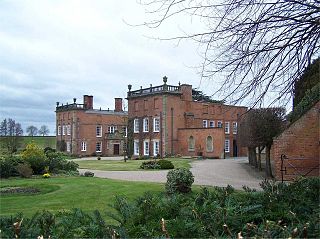
Longford Hall is a 16th-century country house at Longford in the Dales district of Derbyshire, England. It is a Grade II* listed building.
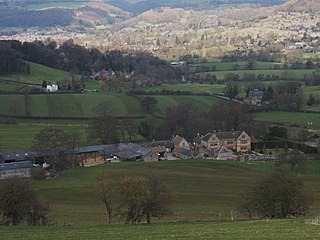
Snitterton Hall is a late medieval manor house in Snitterton in South Darley parish, near Matlock, Derbyshire, England, and within the Peak District National Park. It is a Grade I listed building.

Sir Simon Degge (1612–1703) was High Sheriff of Derbyshire and served North Wales as a Justice. It was said that he served his year as sheriff in "barrister robes and with a sword by his side". Degge was a Royalist and wrote a reference book on the law and rights of a parson called the Parson's Counsellor.... The book includes advice on the income from a glebe, Jus patronatus and the crime of Simony.

Carnfield Hall is a privately owned country house located at South Normanton, near Alfreton in Derbyshire, England. It is a Grade II* listed building. The estate includes around ninety acres of park and ancient woodland.

Sir Peter Fretchville of Staveley, Derbyshire, was an English politician who sat in the House of Commons in 1601 and from 1621 to 1622. In 1604 he built Staveley Hall, which survives today.

Sir Godfrey de Foljambe was a prominent landowner and politician in fourteenth-century England, who was a Baron of the Exchequer and chief steward of the duchy of Lancaster. He went on to have a successful career as an Irish judge, including three years as Lord Chief Justice of Ireland. He was initially a servant of Philippa of Hainault before becoming a prominent member of the affinity of her son, John of Gaunt, Duke of Lancaster. His tomb can still be seen at All Saints Church, Bakewell.
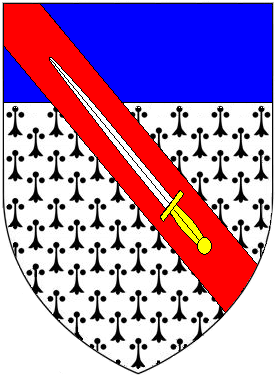
Thomas Gladwin of Tupton Hall, in the parish of Wingerworth near Chesterfield, Derbyshire, was Sheriff of Derbyshire in 1668.
The Hundreds of Derbyshire were the geographic divisions of the historic county of Derbyshire for administrative, military and judicial purposes. They were established in Derbyshire some time before the Norman conquest. In the Domesday Survey of 1086 AD the hundreds were called wapentakes. By 1273 the county was divided into 8 hundreds with some later combined, becoming 6 hundreds over the following centuries. The Local Government Act 1894 replaced hundreds with districts. Derbyshire is now divided into 8 administrative boroughs within the Derbyshire County Council area.

Northwood and Tinkersley is a civil parish within the Derbyshire Dales district, in the county of Derbyshire, England. Named for its main settlements, with a mix of rural and built up areas, it had a population of 665 residents in 2011. The parish is 126 miles (203 km) north west of London, 18 miles (29 km) north west of the county city of Derby, and 3+1⁄2 miles (5.6 km) north west of the nearest market town of Matlock. Northwood and Tinkersley is directly adjacent to the Peak District national park to the west, and shares a border with the parishes of Darley Dale, Rowsley and Stanton.

Winster Hall is a Grade II* listed building in Winster, Derbyshire.
















